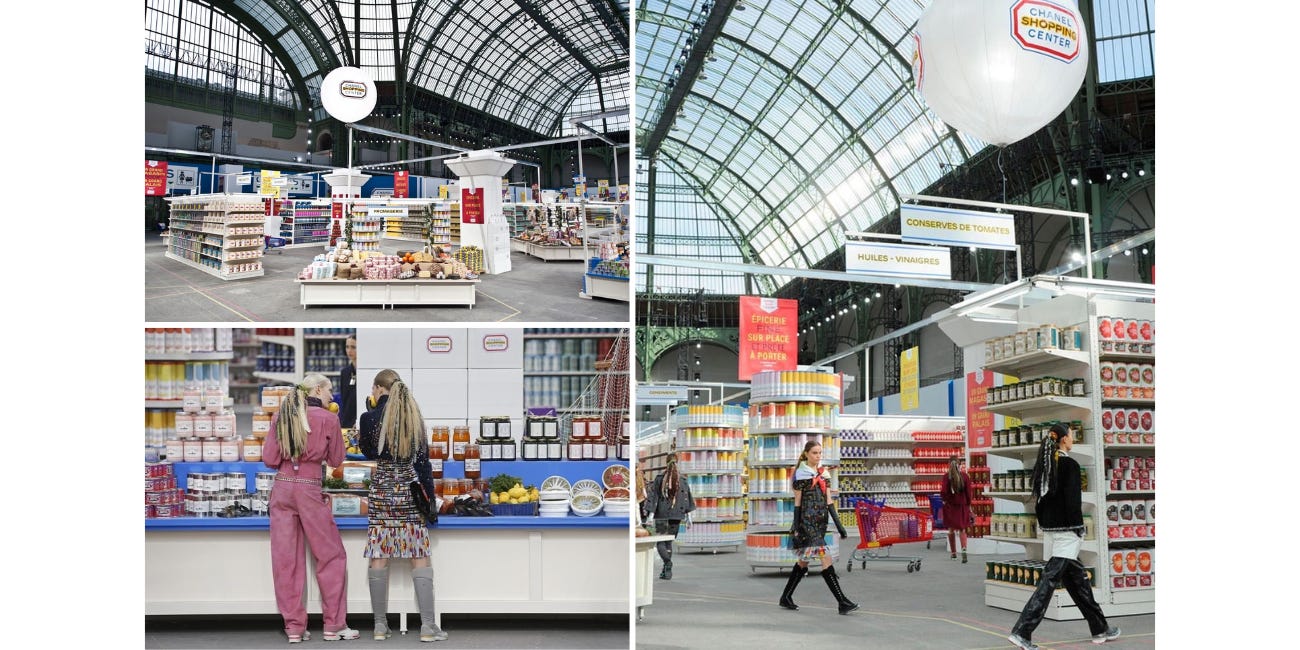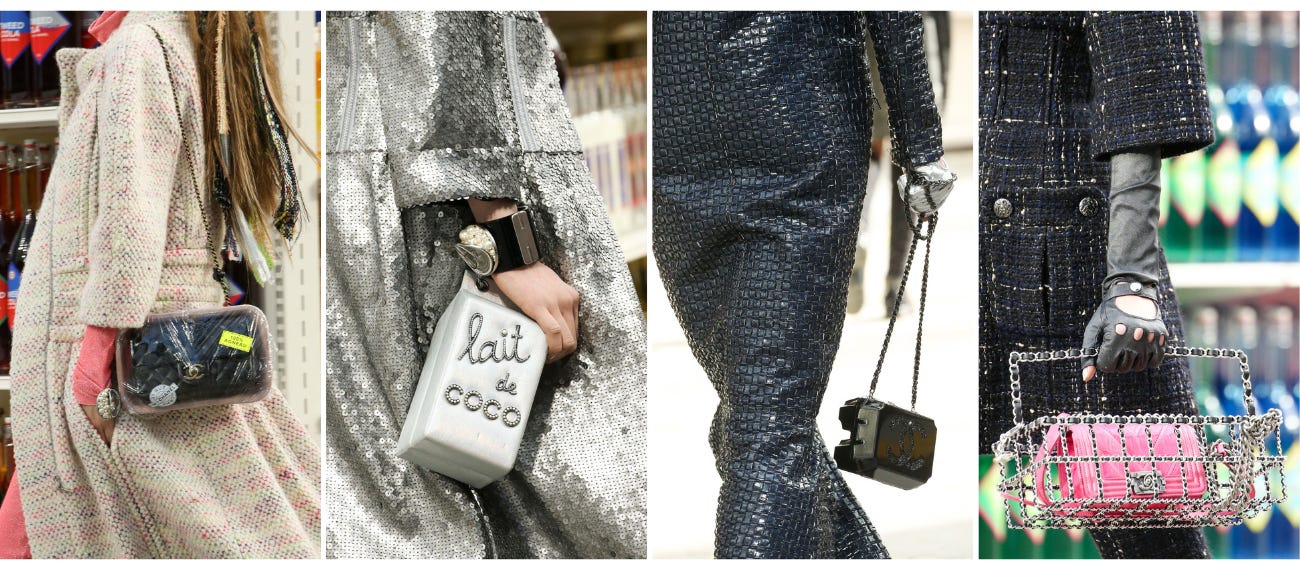Welcome back to Show Notes, where we decode the art of storytelling in fashion’s most iconic runway shows.
For a designer, a fashion show is the ultimate form of storytelling, where every detail comes together to convey a deeper narrative. In this series, we uncover the hidden messages and symbolic ideas woven into a designer’s collection, revealing how they transform abstract concepts into immersive works of art.
For the series’ very first edition, we could look no further than Lee Alexander McQueen and the show we revisited has often been named one of fashion’s most memorable moments. No.13, Spring 1999 explores themes of creation, destruction and rebirth, blurring the lines between fashion and performance art. McQueen created a performance–a clash of humanity and technology–and left us with an unforgettable image of a woman trapped in a moment of transformation. You can read The Machine and the Muse below.
This week, we shift from the moving poetry of McQueen to the grand theatricality of Karl Lagerfeld. Two designers who could not be more different in tone, but who share a devotion to transforming the runway into immersive worlds. Where McQueen’s shows leaned into the visceral and symbolic, Lagerfeld revelled in irony, scale and spectacle.
Lagerfeld’s Chanel universe was one where imagination met meticulous execution, turning the seemingly mundane (a wind farm, an airport, a train station) into moments of magic. In this edition, we explore one of his most talked about concepts–a full-scale Chanel supermarket–where fashion, consumerism and performance collided in unexpected ways.
Please take your seat. The show is about to begin.
Chanel, Fall 2014
When guests entered the Grand Palais on 4 March 2014, they expected another visual marvel from Karl Lagerfeld’s Chanel. But instead of a sleek runway or ornate set, they were met with shelves, aisles upon aisles of them, in a fully stocked feast for the eyes.
The Grand Palais, a historic site now synonymous with the Chanel runway, had been completely transformed to the Chanel Shopping Centre–un grand magasin–and blurred the line between installation and spectacle. True to the grandeur expected of the house, the set was a meticulously constructed supermarket, stocked with over 100,000 items rebranded with the unmistakable double C. Shoppers (or rather, showgoers) browsed shelves lined with Coco Flakes, Delices de Gabrielle, and Lait de Coco, each boldly marked “+50%”. Tea offerings included The Little Black Tea and Jasmin Dragon Pearls, while paint tins bore hues like 1903 Blue Confection and 1914 Jaune Etienne. Every label was laced with a house reference–a playful decoding of the Chanel archives cleverly repackaged as everyday consumer goods.
The set dismantled the divide between fashion space and functional space, demanding the guests to reconsider what, or where, a runway could be. The absurdity of couture in a convenience store wasn’t accidental, it was deliberate, provocative, and deeply Lagerfeld. Few could build worlds like Karl. His shows transported you entirely–from rocket ships to icebergs and data centres–each set grounded his collections in a narrative, giving the clothes context and cinematic scale. Even when outrageous, the staging was Lagerfeld’s way of making fashion feel alive, immersive and unmistakably of the moment.
“Why a supermarket? It is something of today’s life and even people who dress at Chanel go there–it’s a modern statement for expensive things,” Lagerfeld commented after the show. Models sauntered past condiment bottles and cereal boxes in metallic sneaker boots and corseted co-ords. Signature Chanel tweeds were reimagined as oversized coats in multi-coloured textures. Classic flap bags came cling-wrapped, while shopping baskets wrapped in leather quilting carried next season’s most coveted leather goods–one model even sporting an egg-carton clutch.
This was a collection rooted in contradiction: high fashion silhouettes merged with streetwear ease. Grand embellishment met athleticism. It poked fun at luxury while reinforcing it. By walking among commodities, the models became both icons of unattainable style and participants in a familiar, everyday act–shopping.
This was Karl Lagerfeld at his most subversive. In the age of fast fashion and Instagram-fuelled excess, the show offered a playful but pointed commentary on consumerism. Was it mocking the commodification of luxury? Celebrating it? Or both? By placing Chanel within a supermarket, Lagerfeld explored how fashion functions as product, desire, and spectacle all at once. Stefano Tonchi illustrates this sentiment of how the show could be seen as “a counterpart to the refuse on consumerism that Rei Kawakubo wanted to put on the runway, she fights the system. And Mr. Lagerfeld as he said, “I am the system.’”
In this way, the runway operates as a cultural lens, reflecting the values, contradictions and ideologies of the time. “It was a celebration of consumerism but also an epic satire of it” Tim Blanks wrote for Vogue. Lagerfeld’s supermarket was a site of commentary, where the codes of luxury collided with the aesthetic of mass consumption. The show underscored how fashion can serve as both participant in and critic of late capitalism, revealing the blurred lines between aspiration, accessibility, and artifice. Chanel’s runway transcended its traditional role becoming a platform for examining the social rituals of shopping, branding, and identity-making in the 21st century.
For the show’s finale, models didn’t exit backstage. They wandered the aisles. They filled trolleys, picked up fruit, examined labels. Rihanna and Cara Delevingne perched upon a trolley pushed by Joan Smalls. Kendall Jenner strolled down the aisle with a basket of double C-marked goods. It was unscripted, absurd, and yet the perfect crescendo to the show’s theatre. The fashion elite watched as runway became performance art.
At its conclusion came an announcement “Dear valued customer, the Chanel store is now closing. Please feel free to pick up your complimentary fruit and vegetables as you leave.” After the show, guests–momentarily abandoning fashion week etiquette–began raiding the shelves, attempting to pocket Coco-labelled detergent and Chanel-signed produce, only to be stopped by security. And in that moment, Lagerfeld turned the art of consumption into a runway climax.
Named one of the most unforgettable fashion shows ever by Vogue, the Chanel supermarket show remains one of the most talked-about moments in fashion. Not because of what was worn–but because of where it was worn. It pushed boundaries of how fashion could be presented, consumed, and remembered. It proved that even in a world saturated with imagery and immediacy, a show could still surprise. Still delight. Still spark fascination.
“If you have the chance to buy what you want, to afford expensive things, buy them; but use them the way you use things from the supermarket. If not, that’s not luxury; it’s pretension, boredom, stiff, old, depressing even, no?” Lagerfeld stated. He reminded us that fashion doesn’t have to take itself so seriously. When it leans into fantasy, it can reflect the world back to us with biting wit and unforgettable charm. As Tim Blanks so perfectly put “fashion’s a supermarket. So you may as well shop.”











